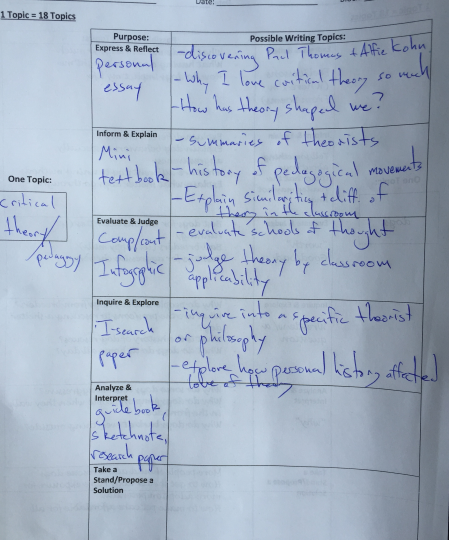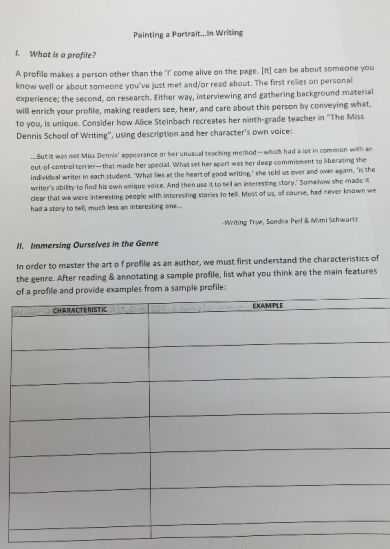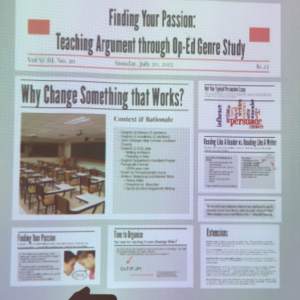Let’s continue!
Dialogue Journal: Writing an honest dialogue/conversation with someone we know well. The process of writing the dialogue allows the relationship and aspects of the relationship to emerge and move forward. First step is make a list of persons you would like to have a dialogue with (Progoff said people die but relationships don’t.) This should be with someone who you know well enough to write their own stepping stones. Someone you’re familiar with. First step is to list people you’d like to have a dialogue with.
Mother
Father
Sister
Uncle David
The point of making the list first is to have a menu to select from. So pick someone. My Uncle passed away yesterday; I’m going to select him. Next write a focus statement.
Focus Statement: Two to three sentences about why I want to have a dialogue with this person. Why did I choose this person?
I want to have a conversation with you, Uncle David. We never really talked or got to know each other. I know this sort of goes against the requirement of knowing the person well, but that’s OK. It’s my writing.
Arbogast talks about the difficulty of conversations. About how we are typically listening only to respond. An I-It relationship where we’re centered on ourselves. This contrasts with an I-Thou relationship that honors the other person. The trick in writing a dialogue is to get to the I-Though relationship. We do this by writing out the stepping stones for that person. Write them in the first person to get a sense of what it must have been like to walk in that person’s shoes.
I’m pretty sure the writing I’m about to do is an I-It relationship. I’ll do my best to follow the instructions.
I was born in Pittsburgh, Pennsylvania in the 1960s. I graduated from college (where I had an amazing time) and moved out to Texas to work for a big company. I took care of my mom for a time. She came to live with us in Texas. She loved the pool. I married, had a daughter, and developed cancer. I spent the final chunk of my life battling the disease.
There’s one final step before we write the dialogue. We close our eyes, relax, and let the imagery present itself to us. Observe the Twilight Imagery and record it.
-Well greased hair
-Tennis outfits
-Sadness, regret, loss
-My mother’s tears
-A big booming voice calling out ‘Pete’
-Hale physicality
-Fuck cancer
-Cancer
Just use initials (to move quickly) and don’t bother with quotation marks. Imagine you’re in the presence of that person. Greet them and let the dialogue go wherever it goes. If it grinds to a halt, imagine that person is sitting with you to see if something emerges. Read back over that person’s stepping stones. Opening line: I Just read your stepping stones and it made me feel…
Into the silence
P: I just read your stepping stones and it made me feel, well, sort of empty.
D: Empty? That’s an odd thing to say. What do you mean?
P: Well, like, I couldn’t remember much about you. Or about us. Or about the family. Why is that?
D: You weren’t really around. I moved halfway across the country. And you know how much this family hates moving.
P: Yea, I don’t want to get off topic, but what’s up with that? It’s definitely a trait of mine. I don’t even like leaving the house past 7:00 pm, much less relocating my physical body multiple states away from home base.
D: I’m not sure. But I don’t think we’re here to discuss family migration patterns.
P: You’re right. But I’m not sure what I want to talk about. I don’t know you. I never really knew you. What invisible bonds does blood create? What tethers us together? Is a family characterized by distance and unknowing still a family? Now that you’ve passed, how should I feel? Last night I conjured up your face. But all I could think about was my mother. Her pain and sadness. The passing of her first sibling launches her into a phase of life that scares me in its finality. The regrets she has about never providing a close-knit extended family. This wasn’t her fault, of course. But I know, or at least can guess, at just how badly she feels.
D: So it sounds like you’re asking me if it’s okay not to miss me.
P: I guess it is. I’m sorry.
D: Why?
P: For never reaching out. For never taking the initiative to instigate some form of communication with my dying uncle. For thinking about you less than I thought about characters on a TV show. How do I remedy this? What penance must be paid for my willful ignorance, my turning away? How can I make this right?
D: You can’t. I’m gone.
P: I’m sorry.
This is intense stuff. We take a break to clear out some of the emotional charge still sitting on top of us.
Inner Wisdom Dialogue is the last activity we’re going to do. The inner wisdom dialogue is one in which we have a conversation from history or mythology or an ancestor or a deity or fiction. Someone who inspires us in a connection with a meaningful life. Make a list of wisdom figures. People who you want to speak with about the big life questions.
David Foster Wallace
Mario Incandenza
Hal Incandenza
Coach Taylor (Friday Night Lights)
Paul Thomas
Alfie Kohn
Trent Reznor
John Dewey
Diane Ravitch
Thom Yorke
Maynard James Keenan
Look at the list. Maybe you’re drawn to one. Maybe you’re pushed away from one (that’s probably the one you should speak with, btw). So pick one. As with the other dialogue, write a focus statement. A simple declaration of a need or a question. What do you want that figure’s help with? I’m going to choose Alfie Kohn.
Focus Statement: How do I sustain a progressive philosophy of education (and life) in the face of such overwhelming odds?
Imagine the figure is walking towards you. Greet them and let the dialogue unfold. The figure might change in the middle of the dialogue. If that happens, go with it.
P: Mr. Kohn!
A: Hello there! It’s so nice to see you. I’ve enjoyed reading your blog posts and your Twitter feed.
P: Really? That’s amazing!
A: What can I do for you?
P: How do I know what I’m doing is the right thing? How do I know I’m on the right path? I read your books. I read your blog. I read your articles. Yet I often feel like everything I experience day-to-day goes against your wisdom.
A: Join the club. I’ve felt that way my entire life!
P: But then how do you know what’s right? How do know that the opinions you’re giving aren’t misguided?
A: Well, why do you ask? Although I’m pretty sure I know the answer already.
P: Because I don’t know what’s right. I don’t know how to teach. Grade or no grades. Test vs no tests. Preparing students for life, for college, for vocational positions, for academia. These tracking systems we have in our society are so ingrained. How do I know what to teach each student?
A: Keep going.
P: What if I’m only doing these things because I think they’re right independent of studies and research and “best practices?” Isn’t that selfish of me?
A: I can’t answer these questions for you.
P: Why not?
A: Because the answers can only come from you. Like you said, this is your system of ethics you’re developing. Your personal philosophy of how education should work.
P: But I want to do what’s right. But what if rubrics are the best way to improve student writing? What if John Dewey was wrong? Or, more accurately, what if I’m only partially right? What if this tiny sliver of knowledge I’ve gleaned over the past twelve months is a misreading? Maybe I’m in over my head. Maybe I only have my own best interests in mind.
A: Do you think that’s true?
P: I don’t know! That’s what I’m asking you! I want a mentor. I need a mentor. I need someone to tell me that what I’m doing is the right thing to do. That I’m heading on a path of authentic experience. That I’m going to make a positive difference to something or someone outside of myself. Or maybe I’m taking this way too personally. I feel like I’m placing myself up on a pedestal of solipsism. A pedagogy of narcissism predicated upon masquerading my own interests as what’s best for students. I’m afraid I’m not good enough for all of this. That I just don’t have what it takes to carry on a progressive, learned approach to teaching and learning. That I have nothing to fall back on. That I’ll look back in five years and hang my head in shame at the misguided techniques I used in the service of some false progressivism I didn’t even know enough about.
A: Keep walking the path. Keep reading. Keep writing. Keep thinking.
P: That’s it?
A: That’s it.
P: I had a feeling you would say that.
Phew! We share out. Tears galore! Mucous out the wazoo!
This is the raw stuff that becomes amazing writing. These journal prompts work really well with students. It helps them generate ideas to write about. Come back to it throughout the quarter and semester and year. Turn these ideas into fiction by changing names. Using the images and phrases to start and end poems. Personal narratives stemming from any of the stepping stones. Poems for two voices with the dialogue. Using the dialogue to help students write…dialogue. Use a literary character and write out his or her stepping stones. Keep recording! Mindfulness! To practice coming home to your body. To becoming aware of existing in a space.
Now we run, partially hollowed out by the emotional purge, to lunch.
















